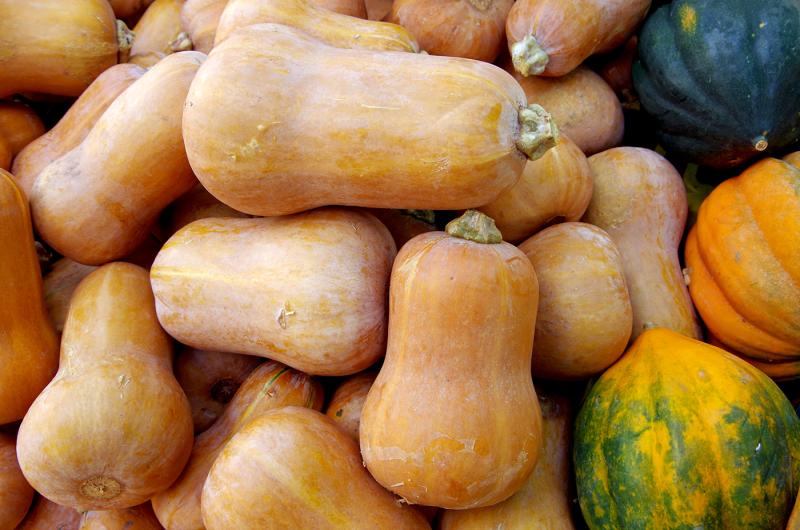
Squash is one of the three plants grown in the traditional Native American gardens known as the Three Sisters. When it is grown in the same field as beans and corn, the large-leafed squash works as a ground cover to smother weeds, while the beans create natural fertilizer via their roots as they grow up the supporting cornstalks.
There is a new squash called honeynut that is sweeter and more nutritious than many others. Honeynut is a winter squash bred by Richard W. Robinson, professor emeritus at Cornell University, from butternut and buttercup squash, combining the best traits of both. It is shaped like a butternut, but about half that size.
Honeynut squash has a deep, intense sweetness that caramelizes into a rich, malt-like flavor when roasted at high heat. The dark-tan to orange skin is thin and edible like an apple peel. The flesh is delicious roasted, grilled, and made into soups and stews, as well as filling for ravioli. Because it is so sweet, it makes a delicious pie filling as well as being good for use in muffins, cookies and cakes.
Sow the seeds directly in the garden after all danger of frost has passed and the soil has warmed up to at least 60°F, preferably 70°F. Squash does not like to have its roots disturbed, so if you start seeds indoors, use peat pots and only plant them 2-3 weeks before setting them out in the garden. Plant them in raised beds or hills about a foot across or in rows 36 inches apart. Choose a spot in full sun with fertile, well-drained soil that has a pH of 6.0–6.8.
Because of the lightweight fruits, you can grow honeynut squash on a fence or trellis and let the squash hang down. The compact vines are perfect to grow in large pots or raised beds. Use mulch to keep weeds down, retain soil moisture and protect the shallow roots. Be careful when weeding to avoid root injuries.
Make sure your honeynut squash get at least 1 inch of water each week. Try to keep water off of leaves and fruit, because moisture can lead to diseases. These hardy vines are resistant to powdery mildew and squash vine borers.
Squash blossoms are pollinated by insects, and poor pollination will result in flowers that do not bear fruit or produce misshapen fruit. To attract pollinators, plant clover, buckwheat or other flowers alongside your vegetables..
The squash will ripen from green to deep orange, and become sweeter and richer-flavored after picking. Cut the fruits when they change from green to buff color. Like all winter squash, let them sit to cure in a dry, warm spot for two or three weeks for the best flavor. You can also eat the leaves and flowers from squash.
Seeds are available from local nurseries and greenhouses or by mail from companies such as Hudson Valley Seed Co. (4737 Route 209, Accord, NY 12404-5754, phone 845-204-8769 or go to hudsonvalleyseed.com).
Plant honeynut squash for an early winter treat and enjoy a vitamin-rich side dish or dessert.
"tasty" - Google News
November 10, 2022 at 06:06AM
https://ift.tt/vdUAgPc
Plant a honey of a squash for tasty winter eating - CapeGazette.com
"tasty" - Google News
https://ift.tt/VnaODzo
https://ift.tt/N7Hpvbo
Bagikan Berita Ini














0 Response to "Plant a honey of a squash for tasty winter eating - CapeGazette.com"
Post a Comment